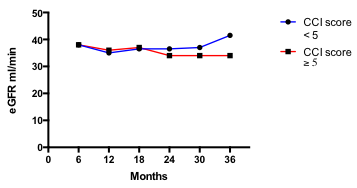Charlson Comorbidity Index (CCI) as Prognostic Indicator of Outcomes in Older Patients Undergoing Renal Transplantation.
Cardiff Transplant Unit, University Hospital of Wales, Cardiff, United Kingdom
Meeting: 2017 American Transplant Congress
Abstract number: A107
Keywords: Age factors, Donors, non-heart-beating, Outcome, Risk factors
Session Information
Session Name: Poster Session A: Deceased Donor Issues I: Allocation, KDPI and Recipient Selection
Session Type: Poster Session
Date: Saturday, April 29, 2017
Session Time: 5:30pm-7:30pm
 Presentation Time: 5:30pm-7:30pm
Presentation Time: 5:30pm-7:30pm
Location: Hall D1
Introduction: Our group has shown excellent results using old DCD donor kidneys to older recipients. There are continuing efforts to predict those older recipients who will fare well with transplantation. The Charlson Comorbidity Index (CCI) has been shown to be a sensitive tool predicting mortality in those with comorbid conditions in different settings. We aimed to assess if we could use CCI as a tool to aid on the prognosis of older candidates, based on patient and graft survival, graft function and first in-hospital stay.
Methods: We investigated a cohort of older (age >60) renal transplant patients; all receiving kidneys from older DCD donors (age >60) who had minimum follow up of 3 years. 62 patients were identified, and CCI was calculated for each patient based on comorbidities at the time of surgery. Spearman correlation was used initially to correlate graft function (eGFR) with CCI. Given the confounding factors we additionally compared the patient and graft survival and function at 1 and 3 years between patients having a CCI<5 compared to those with CCI >5 after correcting for other risk factors.
Results: The CCI score ranged between 2-10. Using Spearman correlation there was no significant correlation of CCI with graft function (eGFR) at 1 year (r=-0.14, p=0.28) or 2 years (r=-0.19, p= 0.15) or in hospital stay (r=0.15, p=0.26). Patient survival at 1 and 3 years was 94% and 90% among those with CCI less than 5, compared to 90% and 76 % respectively in those with CCI greater than 5. Graft survival at 3 years (censored for death) was 97% in patients with CCI less than 5 vs. 90% in those with higher CCI. A graph with the respective eGFRs of the two groups is presented below  Calculated eGFRs seem to divert after 18 months.
Calculated eGFRs seem to divert after 18 months.
Conclusion: In our cohort of patients older than 60 years old, patients with higher CCI had higher mortality at 3 years and, numerically, lower graft survival and graft function (not statistically significant). First in-hospital stay was similar. Given the small number of recipients future studies with larger cohort are needed to confirm these findings.
CITATION INFORMATION: Asderakis A, Contractor U, Khalid U, Donato P, Szabo L. Charlson Comorbidity Index (CCI) as Prognostic Indicator of Outcomes in Older Patients Undergoing Renal Transplantation. Am J Transplant. 2017;17 (suppl 3).
To cite this abstract in AMA style:
Asderakis A, Contractor U, Khalid U, Donato P, Szabo L. Charlson Comorbidity Index (CCI) as Prognostic Indicator of Outcomes in Older Patients Undergoing Renal Transplantation. [abstract]. Am J Transplant. 2017; 17 (suppl 3). https://atcmeetingabstracts.com/abstract/charlson-comorbidity-index-cci-as-prognostic-indicator-of-outcomes-in-older-patients-undergoing-renal-transplantation/. Accessed December 14, 2025.« Back to 2017 American Transplant Congress
